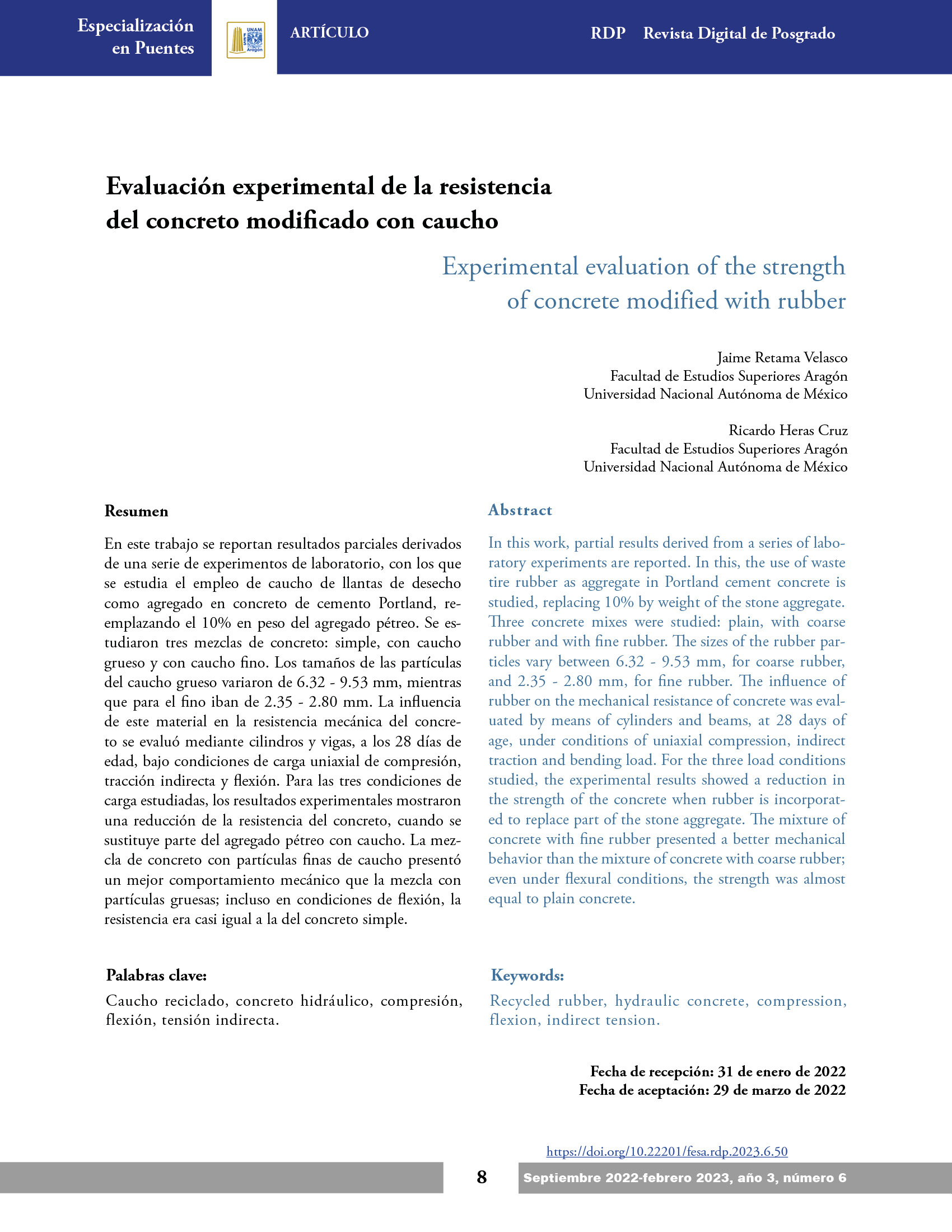Evaluación experimental de la resistencia del concreto modificado con caucho
DOI:
https://doi.org/10.22201/fesa.rdp.2023.6.50Palabras clave:
Caucho reciclado, concreto hidráulico, compresión, flexión, tensión indirecta.Resumen
En este trabajo se reportan resultados parciales derivados de una serie de experimentos de laboratorio, con los que se estudia el empleo de caucho de llantas de desecho como agregado en concreto de cemento Portland, reemplazando el 10% en peso del agregado pétreo. Se estudiaron tres mezclas de concreto: simple, con caucho grueso y con caucho fino. Los tamaños de las partículas del caucho grueso variaron de 6.32 - 9.53 mm, mientras que para el fino iban de 2.35 - 2.80 mm. La influencia de este material en la resistencia mecánica del concreto se evaluó mediante cilindros y vigas, a los 28 días de edad, bajo condiciones de carga uniaxial de compresión, tracción indirecta y flexión. Para las tres condiciones de carga estudiadas, los resultados experimentales mostraron una reducción de la resistencia del concreto, cuando se sustituye parte del agregado pétreo con caucho. La mezcla de concreto con partículas finas de caucho presentó un mejor comportamiento mecánico que la mezcla con partículas gruesas; incluso en condiciones de flexión, la resistencia era casi igual a la del concreto simple.
Citas
American Concrete Institute. (2009). Standard Practice for Selecting Proportions for Normal, Heavyweight, and Mass Concrete (ACI 211.1-91).
American Society for Testing and Materials. (2010). ASTM C293/C293M-10. Standard Test Method for Flexural Strength of Concrete (Using Simple Beam with Center-Point Loading).
American Society for Testing and Materials. (2011). ASTM C496/C496M-11. Standard Test Method for Splitting Tensile Strength of Cylindrical Concrete Specimens.
American Society for Testing and Materials. (2015a). ASTM C192/C192M-15. Standard Practice for Making and Curing Concrete Test Specimens in the Laboratory.
American Society for Testing and Materials. (2015b). ASTM C39/C39M-15a. Standard Test Method for Compressive Strength of Cylindrical Concrete Specimens.
Arioglu, N., Girgin, Z. C., & Arioglu, E. (2006). The Evaluation of Ratio Between Splitting Tensile Strength and Compressive Strength for Concretes Up to 120 Mpa and Its Applications in Strength Criterion. ACI Materials Journal, 103 (1), 18-24. https://www.concrete.org/publications/internationalconcreteabstractsportal.aspx?m=details&ID=15123
Batayneh, M. K., Marie, I., & Asi, I. (2008). Promoting the Use of Crumb-Rubber Concrete in Developing Countries. Waste Management, 28, 2171-2176. DOI: 10.1016/j.wasman.2007.09.035
DeGroot, D. H. (2007). Mexico-US Cross-Border Resolution of Waste Tire Disposal. Proceedings of the 2007 Worlds Environmental and Water Resources Congress. DOI: 10.1061/40927(243)301
Eldin, N. N., & Senouci, A. B. (1992). Use of Scraps Tires in Road Construction. Journal of Construction Engineering and Management, 118(3), 561-576. DOI: 10.1061/(ASCE)0733-9364(1992)118:3(561)
Eldin, N. N., & Piekarski, J. (1993). Scrap Tires: Management and Economics. Journal of Environmental Engineering, 119, 1217-1232. DOI: 10.1061/(ASCE)0733-9372(1993)119:6(1217)
Gere, J. M. & Timoshenko, S. P. (1991). Chapter 5. Stresses in Beams. In Mechanics of materials. Springer-Science Business Media.
Ghaly, A. N., & Cahill, IV J. D. (2005). Correlation of Strength, Rubber Content, and water to cement ratio in rubberized concrete. Canadian Journal of Civil Engineering, 32(6), 1075-1081. https://doi.org/10.1139/l05-063
Girskas, G., & Nagrockiene, D. (2017). Crushed Rubber Waste Impact of Concrete Basic Properties. Construction and Building Materials, 140, 36-42. https://doi.org/10.1016/j.conbuildmat.2017.02.107
Huang, B., Li, G., Pang, J., & Eggers, J. (2004). Investigation into Waste Tire Rubber Filled Concrete. Journal of Materials in Civil Engineering, 16 (3), 187-194. DOI: 10.1061/(ASCE)0899-1561(2004)16:3(187)
Humphrey, D., & Blumenthal, M. (2010). The Use of Tire-Derived Aggregated in Road Construction Applications, Green Streets and Highways Conference 2010. ASCE 2011, 299-313. DOI: 10.1061/41148(389)25.
Khatib, Z.K., & Bayomy, F. M. (1999). Rubberized Portland Cement Concrete. Journal of Materials in Civil Engineering, 11(3), 206-213. DOI: 10.1061/(ASCE)0899-1561(1999)11:3(206)
Li, G., Stubblefield, M. A., Garrick, G., Eggers, J., Abadie, C., & Huang, B. (2004), Development of Waste Tire Modified Concrete. Cement and Concrete Research, 34(12), 2283-2289. DOI: 10.1016/j.cemconres.2004.04.013
Llantrac México. (2022, 24 de junio). Reciclaje de llantas en México, ¿cómo vamos? https://llantrac.com.mx/blog/reciclaje-de-llantas-en-mexico-como-vamos#:~:text=Se%20estima%20que%20en%20M%C3%A9xico,de%20unidades%20podr%C3%ADan%20ser%20reutilizadas.
Ma, F., Dai, J., Fu, Z., Liu, J., Dong, W., & Huang, Z. (2020, October). A New Type of Crumb Rubber Asphalt Mixture: A Dry Process Design and Performance Evaluation. Applied Sciences, 10, 372. DOI: 10.3390/app10010372
Oden, J. T., & Ripperger, E. A. (1981). Chapter 4. Stresses and Stress Resultants in Bars. In Mechanics of elastic structures. McGraw-Hill.
Presti, D. L. (2013). Recycled Tyre Rubber Modified Bitumens for Road Asphalt Mixtures: A Literature Review. Construction and Building Materials, 49, 863-881. DOI: 10.1016/j.conbuildmat.2013.09.007
Retama, J., & Ayala, A. G. (2017). Influence of Crumb-Rubber in the Mechanical Response of Modified Portland Cement Concrete. Advances in Civil Engineering, 2017, 1-9. DOI: 10.1155/2017/3040818
Sadowski, T., & Pietras, D. (2014). Description of Degradation Process of Rubberized Lean Concrete. Solid State Phenomena, 216, 67-72. DOI: 10.4028/www.scientific.net/SSP.216.67
Shu, X., & Huang, B. (2014). Recycling of Waste Tire Rubber in Asphalt and Portland Cement Concrete: An Overview. Construction and Building Materials, 67B, 217-224. https://doi.org/10.1016/j.conbuildmat.2013.11.027
Tajik, N. (2011). Chapter 2. Factors Influencing on the Early Age Thermal Cracking. In Early Age Thermal Cracking in Concrete Structures. Lab Lambert Academic Publishing.
Topcu, I. (1995). The Properties of Rubberized Concretes. Cement and Concrete Research, 25(2), 304-310. DOI: 10.1016/0008-8846(95)00014-3
Xue, G., & Pei, Z. (2018). Experimental Study on Axial Compressive Properties of Rubber Concrete at Low Temperature. Journal of Materials in Civil Engineering, 30(3), 1-8. DOI: 10.1061/(ASCE)MT.1943-5533.0002178
Youssf, O., Mills, J. E., & Hassanli, R. (2016). Assessment of the Mechanical Performance of Crumb Rubber Concrete. Construction and Building Materials, 125, 175-183. DOI: 10.1016/j.conbuildmat.2016.08.040
Zhang, Y., Liu, Z., & Peng, J. (2019). Silane Modification of Crumb Rubber on The Rheological Properties of Rubberized Asphalt. Applied Sciences, 9, 1-11. DOI: 10.3390/app9224831

Descargas
Publicado
Cómo citar
Número
Sección
Licencia
Derechos de autor 2022 Universidad Nacional Autónoma de México

Esta obra está bajo una licencia internacional Creative Commons Atribución-NoComercial-SinDerivadas 4.0.




